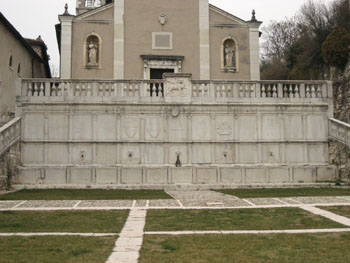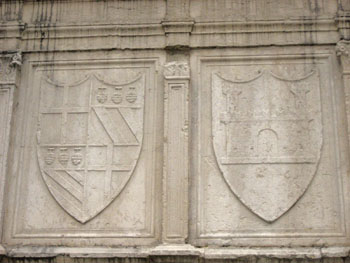| Card n. | Description | Locality | Linked sites |
| 74 | Lombardesque Fountains of Feltre | Feltre | 12 |
| file .pdf | Architecture Art History (ASA) | Google maps |
 |
 |
- Description
- How to get there
- Interesting facts
- Bibliography
Piazza Maggiore is home to the most important and best known of the fifty or so fountains in Feltre. The monument was created at the end of the 15th century by stonecutters from the Lombardo family and restored around 1520. It is divided into thirteen rectangular sections surrounded by frames and square pilasters, arranged on three levels, featuring the coats of arms of the Rectors and the town of Feltre, which were presumably once painted, because during the restoration work carried out in 1998, microscopic traces of colour were found. The engravings were carved during the time Feltre was under the dominion of the French. The monumental front of the fountain is two metres thick, and is in white limestone from the quarry of San Vito di Fastro; it is just one part of a large water tank begun in 1487 by the Rector Angelo Emiliani, the vaults of which are covered by the courtyard of the sixteenth-century Church of San Rocco above. The cistern, supplied with water from an aqueduct that diverted the water from the Faont valley and came up the north face of the hill before distributing the water to the fountains in the city through narrow underground channels. Access to the tank of the fountains is provided by a small metal door on the eastern side. The fountain has five spouts, surrounded by putti and mascarons, with bronze torches for the water to come out of. In 1865 the architect Giuseppe Segusini from Feltre drafted a project – which was never implemented - to turn the fountain into a monument to celebrate the 600th anniversary of the birth of Dante Alighieri, by inserting a medallion into it and flanking it with statues of Vittorino da Feltre and Panfilo Castaldi. These statues were later placed on the lower edge of the Piazza.
The Lombardesque fountains can be seen in the historic Piazza Maggiore, within the city walls, and can be reached on foot by walking up Via Mezzaterra or Via Luzzo, through the historic gates of Porta Castaldi and Porta Oria, or up the steps in Campo Giorgio, at the foot of the southern walls.
ACCESSIBLE: from the outside
MUNICIPALITY: Feltre
PLACE: Piazza Maggiore
GEOGRAPHICAL COORDINATES: X 1725296 - Y 5100248
PROVINCE: Belluno
FILE COMPILED BY: Lonzi
In 1522, construction work was completed on a bridge, probably covered, over the Cismon torrent, designed by Andrea Palladio for Giacomo Angarano. The structure, also described in Palladio’s Four Books of Architecture, does not coincide with that of the existing bridges, but made it possible to cross the torrent for thirty years, “without placing poles in the water”. This bridge was the first in a long series of bridges designed by Palladio.
T. Conte - P. Rossi, Feltre. Guida, Feltre, 2003
G. Zanella, Giuseppe Segusini, le fontane lombardesche e le pietre del feltrino, con un’appendice sul recente restauro, in Perco D., Uomini e pietre nella montagna bellunese. Quaderno 17, Belluno, 2002
P. Rugo, Riflessi del Danubio e della caduta della Repubblica Veneta nelle lapidi della cittadella di Feltre, Feltre, 1999
Le fontane pubbliche del Feltrino, un patrimonio da tutelare, Convention Papers, Rasai, 1997
A. Cambruzzi. - A . Vecellio., Storia di Feltre, Feltre, 1873

